Boston MBTA
17 Products
Active Filters
Filter by Category
Filter by Color
Filter by Price
Min Price:
Max Price:
-
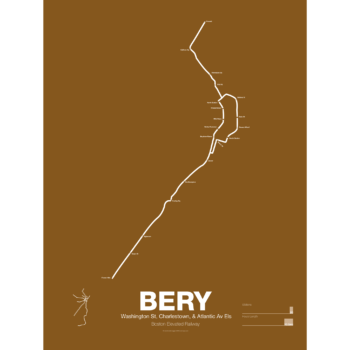
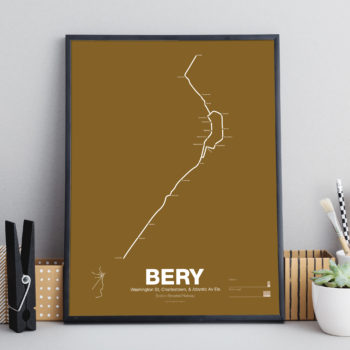 $30.00 – $80.00
$30.00 – $80.00What is today the Orange Line was part of the original Boston Elevated Railway subway and elevated network. Today the only section remaining is the Washington St Tunnel from Haymarket to Chinatown. Originally there were two lines through downtown: the Main Line and the Atlantic Ave El. The Main Line served elevated branches from Charlestown and along Washington St to Dudley Sq. in the South End. The Atlantic Ave El ran from Castle Sq. in the South End to North Station along Atlantic Ave to serve the maritime industries along the waterfront.
As the city grew so did the elevated lines, being extended to Forest Hills and Everett (a further extension to Malden was halted until the 1970s). As the maritime industry faded and ridership dropped the Atlantic Ave El was demolished and sold for scrap during World War II.
While the El served the city well it was not popular as it was loud, dark, and dirty. Plans were laid as early as 1945 to remove the El and rebuild as a subway.
In the 1970s the city canceled ambitious plans to run highways through and around the city and monies were transferred to subway construction. The northern section was rebuilt first, removing the elevated tracks through Charlestown and moving them west along a new subway to Malden in 1975.
The southern section was rebuilt along the route for the canceled I-95 expressway through Jamaica Plain to Forest Hills in 1987. While the new Orange Line was modern and fast the new route bypassed the existing community of Roxbury which relied heavily on mass transit. Service along the old route was replaced by the Silver Line bus in 2002.
Printed on Satin finish 80# cover stock – 220 GSM. Made in the USA! Standard production time is 5 Days. Please add more time for shipping.
Select options This product has multiple variants. The options may be chosen on the product page -
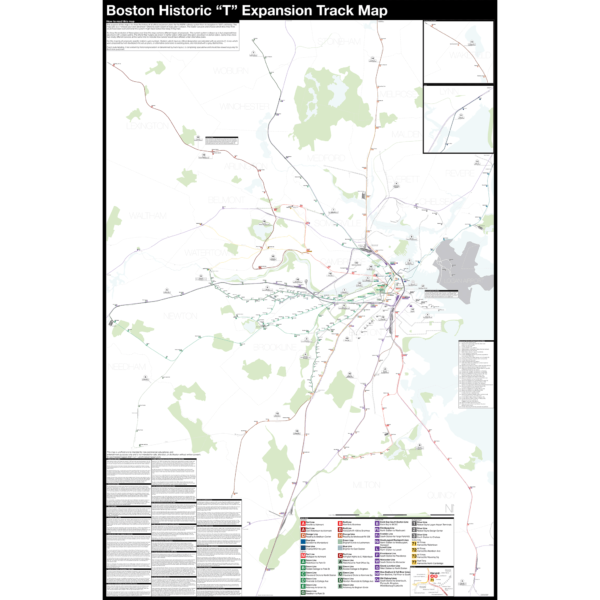
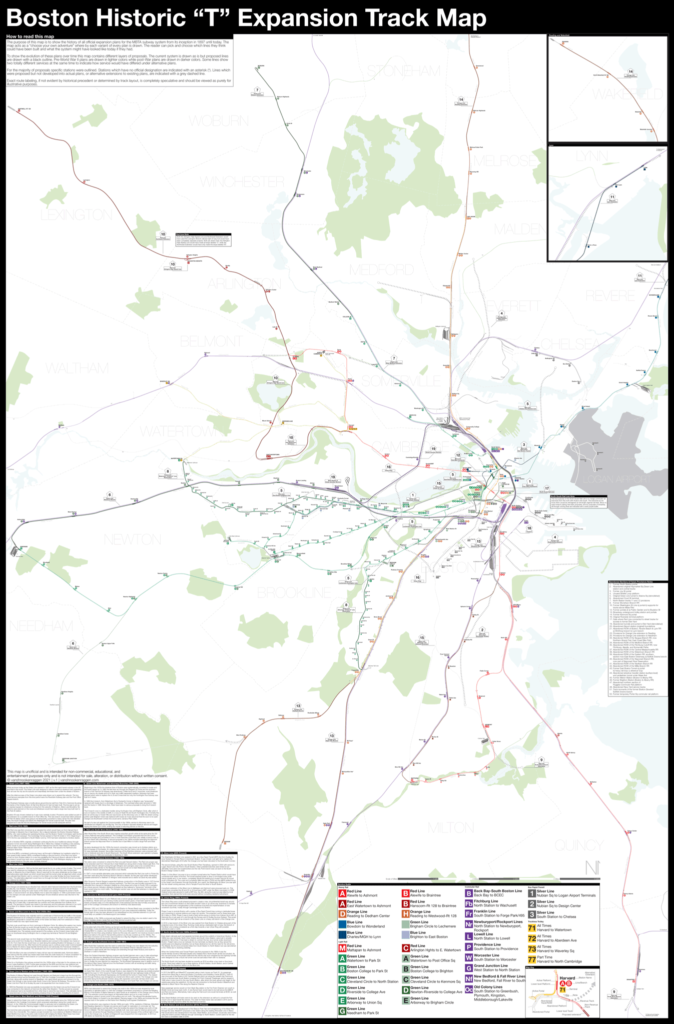 $375.00 – $500.00
$375.00 – $500.00Boston opened the first subway in the US in 1897 and immediately began expanding it. Since then numerous plans have been drawn up, some are simple extensions while others are whole sale reimaginations of the subway. This map shows in detail each official proposal with the history of each idea.
The map acts as a “choose your own adventure” where by each variant of every plan is drawn. The reader can pick and choose which lines they think could have been built and what the system might have looked like today if they had.
Fine art prints are made in Williamsburg, Brooklyn NY on Semi-Gloss, 10mil Premium Luster Paper.
For more information about the map see the original blog post here.
Select options This product has multiple variants. The options may be chosen on the product page -
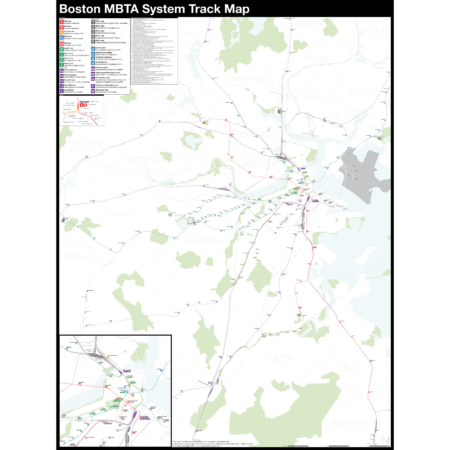
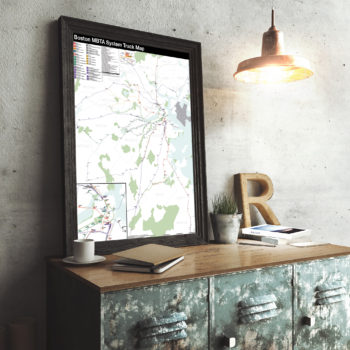 $325.00 – $450.00
$325.00 – $450.00NEW version 3 with Green Line Extension!
The Complete and Geographically Accurate Boston MBTA Subway Track Map is a new detailed look at the subway system that most riders never see. Unlike a traditional subway map which just shows train routes, stations, and a simplified geography for easier navigation, the Track Map shows how the system actually looks; each track, each switch, each station platform and each train yard is shown in a clear and clean design. While the Track Map offers a service guide it is not intended to replace the subway map as a wayfinding tool. The Track Map shows the paths of the tracks so that the viewer can see how trains are able to run. If you’ve ever wondered why certain trains don’t run to certain places this map will tell you why.
The idea behind this was to remove all distortion from traditional subway maps and see the system down to its bones. Street labels, parks, cemeteries, and airports help act as landmarks. The more complicated interchanges and interlockings are shown in a blown up detail section along with a list of as many provisions and abandoned sections of the system I have discovered.
Fine art prints are made in Williamsburg, Brooklyn NY on Semi-Gloss, 10mil Premium Luster Paper.
For more information about the map see the original blog post here.
Select options This product has multiple variants. The options may be chosen on the product page -
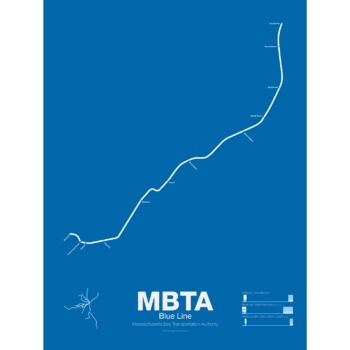
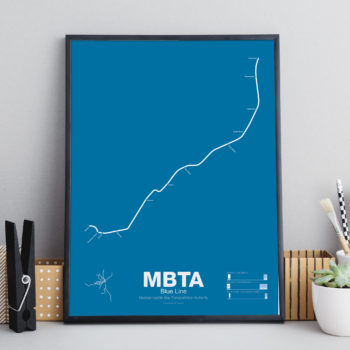 $30.00 – $80.00
$30.00 – $80.00The Blue Line started off as a trolley tunnel to connect Scollay Sq. in downtown Boston to Maverick Sq. in East Boston. It holds the distinction as the first underwater transit tunnel (under a major body of water) opening in 1904. Initial plans called for it to be connected to the Green Line to form a subway trolley network connection all points north, east, south, and west. However, in 1924, the line was converted to heavy rail and extended to Bowdoin Sq. The Blue Line diverted traffic away from East Boston ferries which, ironically, helped bring the demise to the Atlantic Ave elevated line.
Until the 1950s the Blue Line was connected to the Red Line at Charles St so that Blue Line trains could be serviced at the Red Line train shops in Harvard Sq. In 1952 the Blue Line was extended to Suffolk Downs along the abandoned Boston, Revere Beach and Lynn Railroad and two years later extended to Revere where it still terminates at Wonderland.
Printed on Satin finish 80# cover stock – 220 GSM. Made in the USA! Standard production time is 5 Days. Please add more time for shipping.
Select options This product has multiple variants. The options may be chosen on the product page -
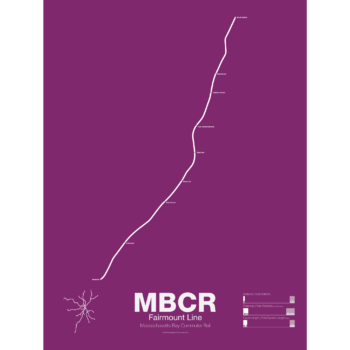
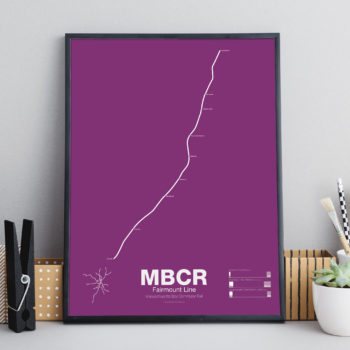 $30.00 – $80.00
$30.00 – $80.00The Fairmount Line is the shortest MBTA commuter rail line and the only one which runs entirely within the city limits of Boston. Originally built as part of the Norfolk County Railroad, the line opened in 1855 and was extended to Walpole, Franklin and Providence. Originally the line ran through South Boston and across the Fort Point Channel to reach its terminal. By 1898 the line had been leased to J.P. Morgan’s NY, New Haven and Hartford Railroad and when South Station opened the following year the original alignment through South Boston was abandoned. Passenger service was ended in 1944 but when the MBTA was building their Southwest Corridor rail project (rebuilding the Orange Line and Amtrak’s Northeast Corridor) they upgraded the Fairmount Line and rerouted all passenger service starting in 1979. When the Southwest Corridor opening in 1987 all service south of Readville was rerouted and the Fairmount Line was reduced to a shuttle. In the early 2000s planners and community advocates proposed adding stations and more service to the line to act as a new subway line, the Indigo Line. Four new stations were added as well as additional service but service remains less than rapid transit levels (mostly due to the use of diesel engines) and fares are higher than that of the subway and bus, limiting potential ridership.
Printed on Satin finish 80# cover stock – 220 GSM. Made in the USA! Standard production time is 5 days. Allow more time for shipping.
Select options This product has multiple variants. The options may be chosen on the product page -
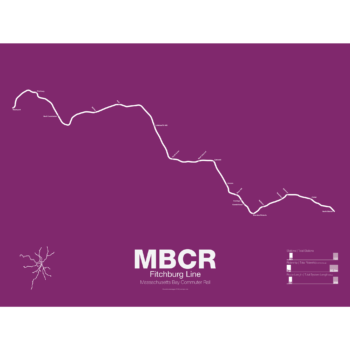
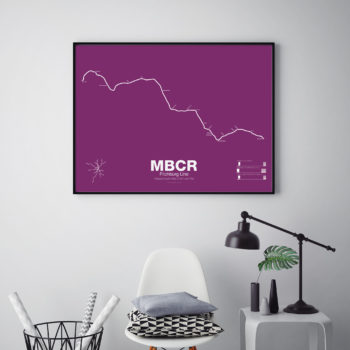 $30.00 – $80.00
$30.00 – $80.00The Fitchburg Line opened between 1840 and 1845 connecting Boston and Fitchburg. The line was extended along the northern frontier of the state before briefly running through southern Vermont on its way to Troy, NY. Traffic on the line slowed after World War 2 and by the 1960s service had been cut back as far as West Concord. After substantial investment by the state, service to Gardner was opening in 1980 but cut back again, this time to Fitchburg in 1987. In 2016 service was extended to Wachusett. The Fitchburg is the second longest line in the commuter rail system but due to decades of deferred maintenance the line suffers from the worst on time performance. Many stations are not ADA compliant and the line features many tight curves through the mountains. Until 2017 the line also had about 9 miles of single track segments which limited capacity, although today only a short section through Waltham remains single tracked.
Printed on Satin finish 80# cover stock – 220 GSM. Made in the USA! Standard production time is 5 days. Allow more time for shipping.
Select options This product has multiple variants. The options may be chosen on the product page -
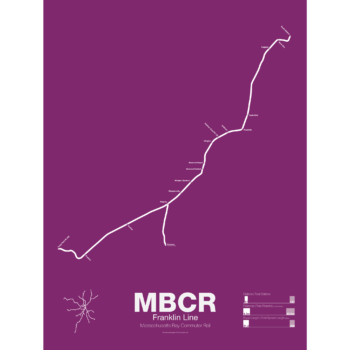
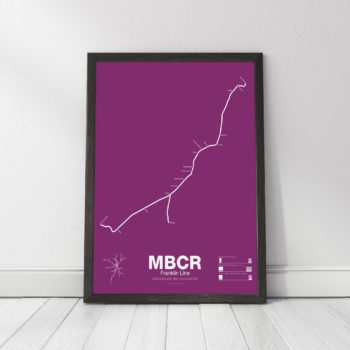 $30.00 – $80.00
$30.00 – $80.00The Franklin Line was original built as part of the Norfolk County Railroad, the line opened in 1855. Originally the line ran through South Boston and across the Fort Point Channel to reach its terminal. By 1898 the line had been leased to J.P. Morgan’s NY, New Haven and Hartford Railroad and when South Station opened the following year the original alignment through South Boston was abandoned. Passenger service ran from New York City via Waterbury and Hartford, CT but by 1966 service had been cut back to Blackstone, MA. The MBTA required towns not within their district to subsidize service themselves and only Franklin was willing to do so. Service was extended to Forge Park/495 in 1988 which was part of a separate railroad. Today service runs to Boston via the Northeast Corridor, although some rush hour trains use the Fairmount Line. Service to Foxboro is run only for football games and special events, although a new pilot program featuring weekday service to Foxboro is now being tested.
Printed on Satin finish 80# cover stock – 220 GSM. Made in the USA! Standard production time is 5 days. Allow more time for shipping.
Select options This product has multiple variants. The options may be chosen on the product page -
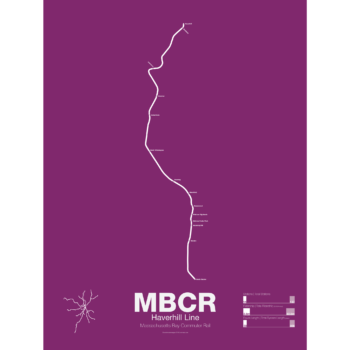
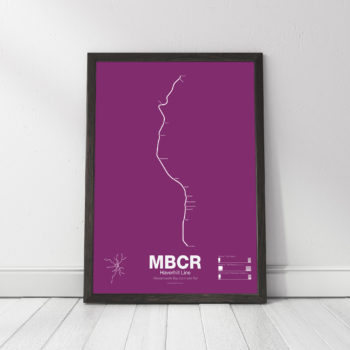 $30.00 – $80.00
$30.00 – $80.00The Haverhill Line was part of the Boston & Maine Railroads first line as the Andover & Haverhill Railroad in 1837. It was later extended to Portland, Maine in 1839. In 1959 passenger service between Wilmington and Boston was ended and all service to Haverhill and beyond was moved over to the Wildcat Branch which connected to the Lowell Line in Wilmington. The newly formed MBTA drew up plans to rebuild the section from Reading to Boston as a relocated and expanded Orange Line. Community opposition and limited funds meant that the Orange Line extension north ended at Oak Grove. Because of the compromise between Orange Line and commuter rail, much of the line to Reading is single tracked which forces some trains to use the Wildcat Branch.
Printed on Satin finish 80# cover stock – 220 GSM. Made in the USA! Standard production time is 5 days. Allow more time for shipping.
Select options This product has multiple variants. The options may be chosen on the product page -
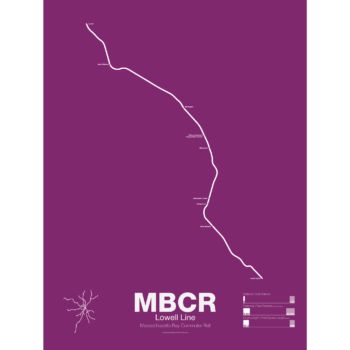
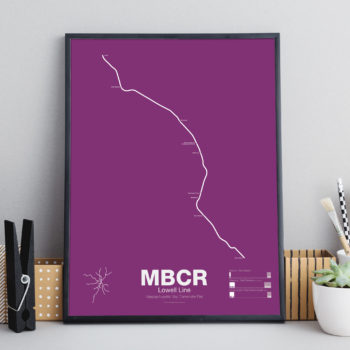 $30.00 – $80.00
$30.00 – $80.00The Lowell Line was one of the first railroads in the United States opening as the Boston & Lowell in 1835 to service the Lowell textile mills. The line was expanded and soon reached all the way to Canada. The Boston & Maine acquired the railroad in 1895. The line was bought by the MBTA in 1973. Service was briefly extended to Concord, NH in 1981 but was ended when federal funding was withdrawn.
Printed on Satin finish 80# cover stock – 220 GSM. Made in the USA! Standard production time is 5 days. Allow more time for shipping.
Select options This product has multiple variants. The options may be chosen on the product page -
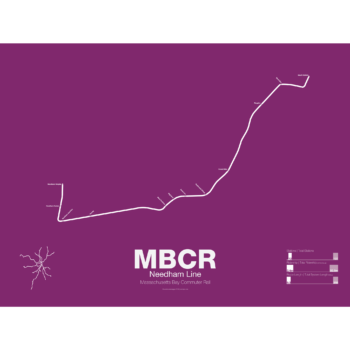
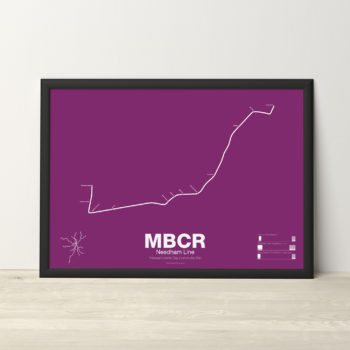 $30.00 – $80.00
$30.00 – $80.00The Needham Line is the second shortest MBTA commuter rail branch and the only one which was never part of a larger intercity line. First opened as a branch of the Boston & Providence Railroad in 1834, the line ran through West Roxbury to Dedham where it connected back to the Main Line in Hyde Park. A second railroad, the Charles River Branch, was built through Newton and Needham in 1853 and was used to haul gravel from Needham quarries to fill in the Back Bay. The Needham Cutoff, connecting the two railroads, was opened in 1906 and was run as a loop between Boston and it’s growing western suburbs. When the MTA, the predecessor of the MBTA, opened the Riverside “D train” Green Line branch in 1959 the loop service was ended. When the MBTA drew up plans to relocate its Orange Line elevated train to a new subway along the proposed Southwest Expressway (which was canceled in 1971) it planned to convert the Needham Line into a branch of the new Orange Line. Community opposition and a lack of funds stopped such an extension but the Orange Line tracks extend along the Needham Line past Forest Hills as provisions for a future conversion.
Printed on Satin finish 80# cover stock – 220 GSM. Made in the USA! Standard production time is 5 days. Allow more time for shipping.
Select options This product has multiple variants. The options may be chosen on the product page -
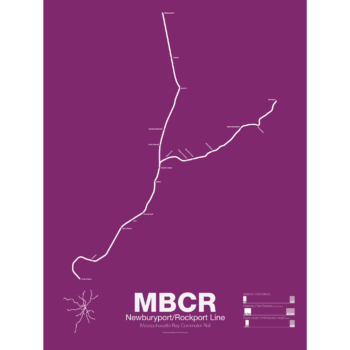
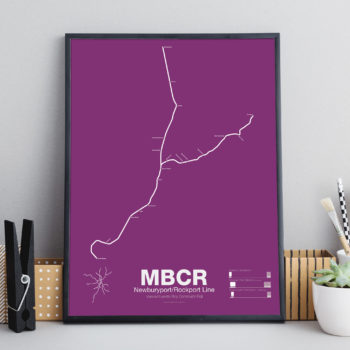 $30.00 – $80.00
$30.00 – $80.00The Newburyport/Rockport Line was part of the Eastern Railroad which connected Boston and Portsmouth, NH in 1836. The branch to Rockport opened to Gloucester in 1847 and was extended to Rockport in 1861. Originally the line ran to East Boston where passengers would continue to Boston proper via ferry. When the Grand Junction Railroad opened in 1854 trains gained access to Boston via Charlestown. The Boston & Maine Railroad leased the line in 1884 and was acquired by the MBTA in the 1970s. Service was slowly cut back over the next decade but the line was upgraded and service to Newburyport restored by 1998.
Printed on Satin finish 80# cover stock – 220 GSM. Made in the USA! Standard production time is 5 days. Allow more time for shipping.
Select options This product has multiple variants. The options may be chosen on the product page -
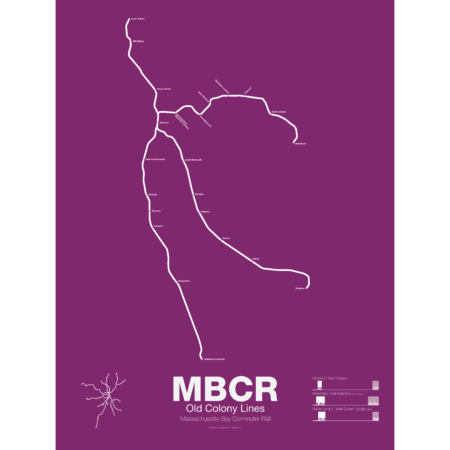
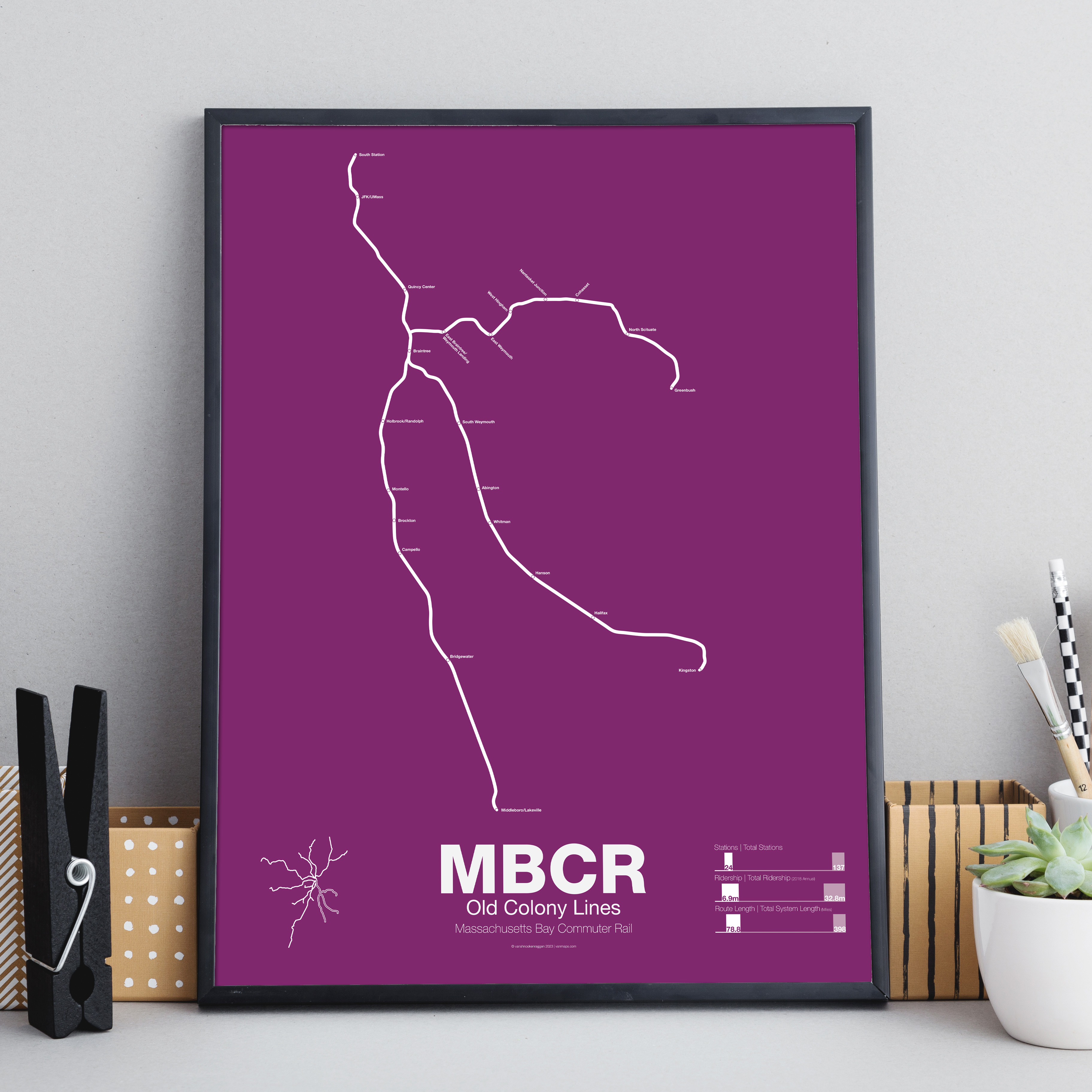 $30.00 – $80.00
$30.00 – $80.00The Old Colony Lines are all that remain of the Old Colony Railroad which served southern Massachusetts and Cape Cod. The first line ran to Plymouth in 1845 with a second branch to Fall River via Middleborough opening in a year later. Service to Fall River was part of a “boat train” where passengers would board a steamship to New York City. The Greenbush Branch opened in 1849 as a separate charter under the South Shore Railroad but this was separated from the Old Colony in 1854. By 1893 J.P Morgan’s NY, New Haven and Hartford Railroad had taken control of both railroads. In 1958, due to financial difficulty, the NYNH&H stopped all passenger service on the Old Colony Lines, stranding riders and growing south shore suburbs. The MTA, and its successor the MBTA, saw the potential of extending rapid transit service along the former railroad and designed a more suburban oriented subway line which used large park-and-ride facilities to appeal to suburban drivers. The MBTA Red Line was extended to Quincy in 1971 and Braintree in 1980. Commuter rail service to Plymouth and Middleborough was restored by 1997. The Greenbush branch, which was in worse shape than the others, took another decade to open. When the Middleborough branch was being rebuilt, plans included extending service as far as Buzzards Bay but were ultimately scrapped due to funding. Today service to Cape Cod is provided by the CapeFLYER from Memorial Day to Columbus Day as a joint operation by the MBTA and CCRTA, although no official MBTA commuter rail service has been adopted.
Printed on Satin finish 80# cover stock – 220 GSM. Made in the USA! Standard production time is 5 days. Allow more time for shipping.
Select options This product has multiple variants. The options may be chosen on the product page -
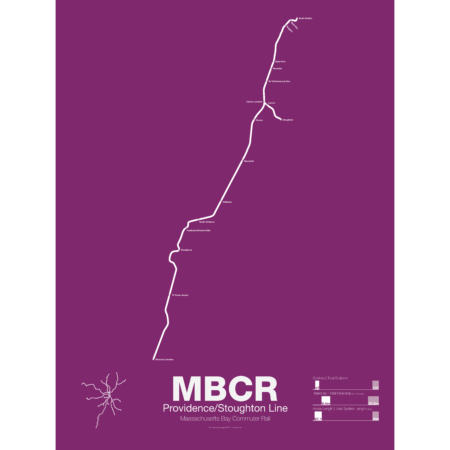
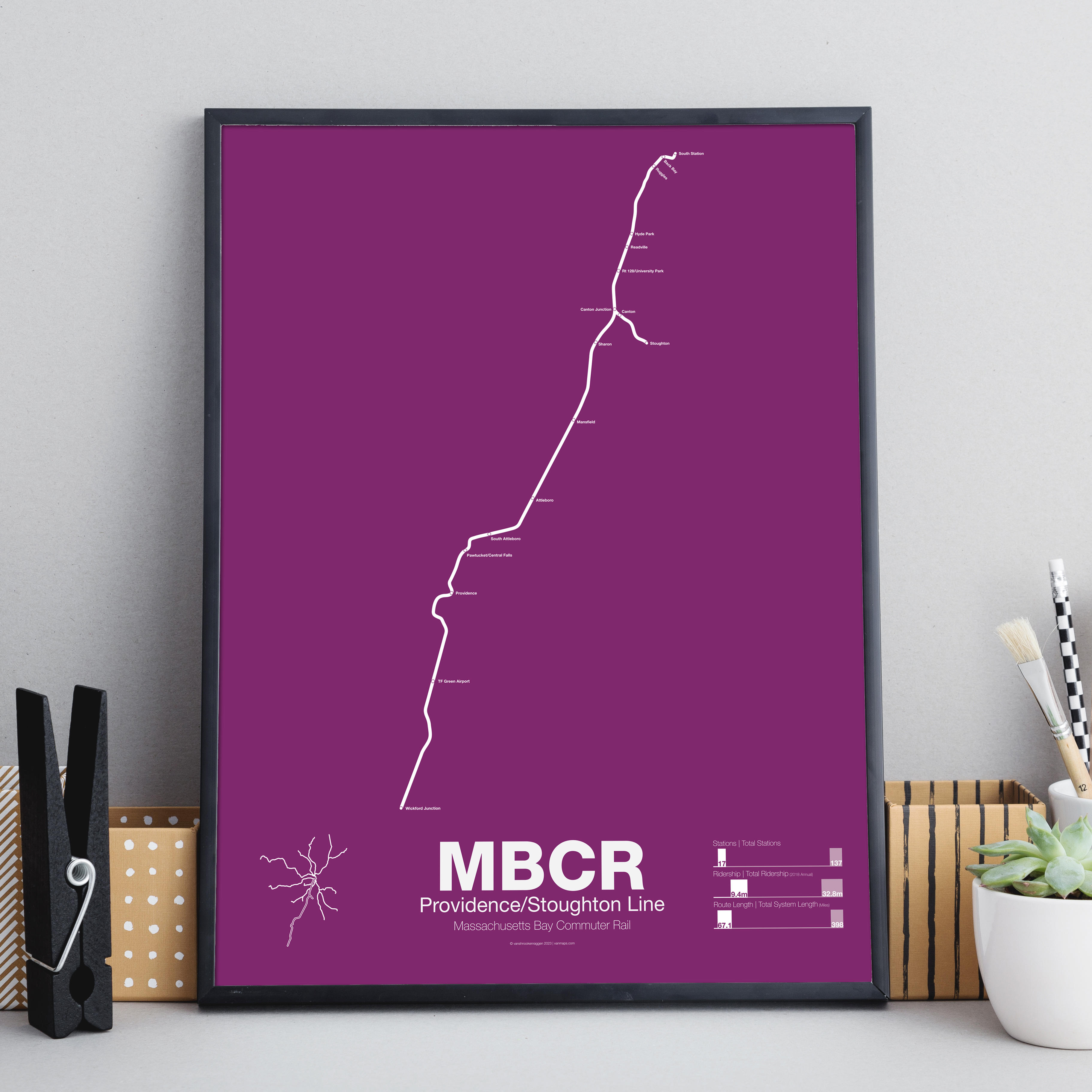 $30.00 – $80.00
$30.00 – $80.00The Providence/Stoughton Line was one of the first railroads in the United States chartered as the Boston & Providence Railroad in 1831. Running through the Jamaica Plain section of Roxbury the railroad helped transform the area into one of the first suburbs in America. Originally the line had to cross the Back Bay between Roxbury and Boston on a viaduct and its depot was built at Park Sq, then filled in land on the coast of the city. When the Back Bay was filled in the street layout was designed around the diagonal run of the Boston & Providence tracks. In 1888 the B&P was leased to the Old Colony Railroad which itself was leased by J.P. Morgan’s NY, New Haven & Hartford Railroad in 1893. In the 1970s, after being bought by the Penn Central and then Conrail, the Providence-Boston route was bought by the MBTA. In 2012 service was extended to Wickford Junction, RI. Service from Providence to Foxboro is run for football games and special events. The Stoughton branch has only two stations but will be extended south to Fall River and New Bedford as part of the South Coast Rail project now under construction.
Printed on Satin finish 80# cover stock – 220 GSM. Made in the USA! Standard production time is 5 days. Allow more time for shipping.
Select options This product has multiple variants. The options may be chosen on the product page -
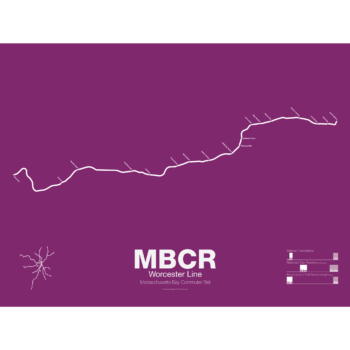
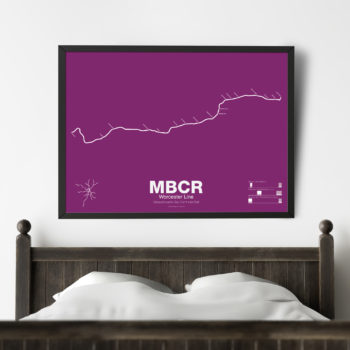 $30.00 – $80.00
$30.00 – $80.00The Worcester Line first opened as the Boston and Worcester Railroad in 1834 and was one of the first railroads with commuter-oriented service. Once part of the Boston and Albany Railroad service was extended to New York and beyond. The line had four tracks from Boston through Newton but when the Massachusetts Turnpike was extended to Boston in 1964 the line was reduced to two tracks and many of the H.H. Richardson stations were demolished to make way for the highway. The Boston and Albany rail yard in Back Bay was sold off and redeveloped as the Prudential Center with the Worcester Line running through the development. Service to between Albany and Worcester was ended in 1970 but restored in 1975. The Worcester Line is not entirely owned by the MBTA and suffers from delays by freight trains and poor quality track. Because of this many trains are short turned at Framingham, which is the limit of MBTA ownership. Two new stations within Boston have opened recently, the Boston Landing station to serve the New Balance headquarters in Brighton and the Landsdown (previously Yawkey) station to serve Fenway. A new station has been proposed in Allston, West Station, as part of a new transit oriented development.
Printed on Satin finish 80# cover stock – 220 GSM. Made in the USA! Standard production time is 5 days. Allow more time for shipping.
Select options This product has multiple variants. The options may be chosen on the product page -
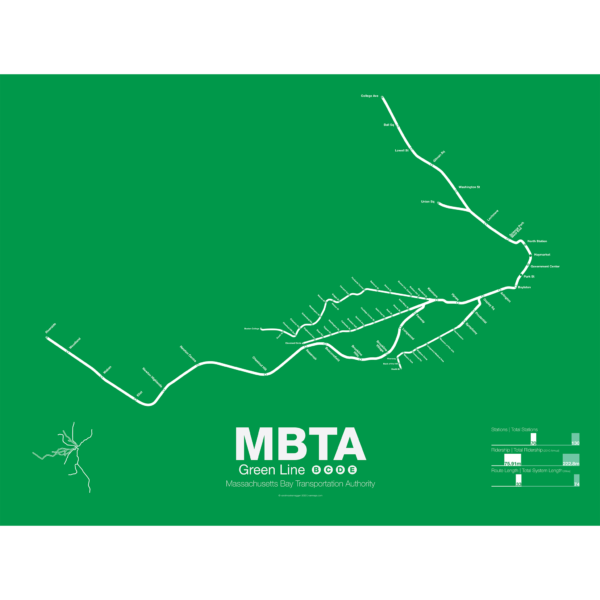
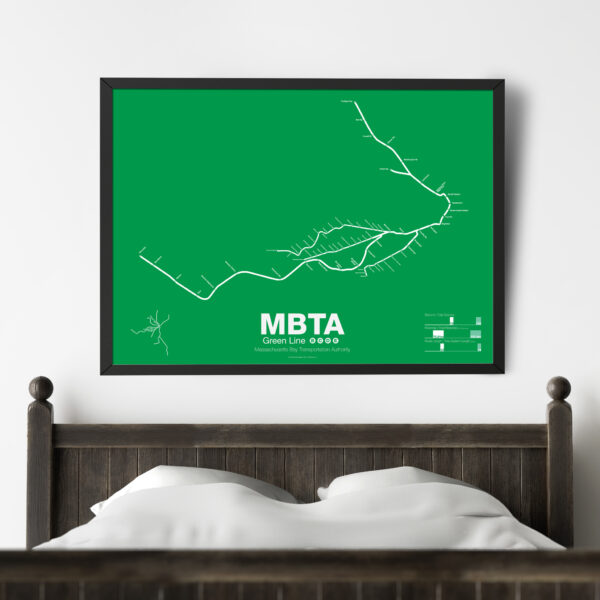 $30.00 – $80.00
$30.00 – $80.00The Green Line is part of the oldest subway in the United States. The short section between Boylston St and Park St opened in 1897 as a way to divert heavy trolley traffic which came downtown from Allston, Brighton, Brookline, Jamaica Plane, Roxbury, and Dorchester. It was quickly expanded to North Station to serve trolley traffic from the northern suburbs.
As commuting patterns changed due in part to the success of the subway the Green Line was extended west to Kenmore Sq and in the 1940s southwest along Huntington Ave. As more and more commuters chose to travel in private automobiles ridership on the trolleys dropped. In 1959 the Riverside branch was opened along a former commuter rail line through Newton. A rebranding of the MBTA system in 1967 renamed the branches that were left as the A, B, C, D, and E branches. The A branch to Watertown Sq. only lasted two more years before finally being axed in 1969.
Boston College B Branch trains run along Commonwealth Ave to Government Center; Cleveland Cirlce C Branch trains run along Beacon St to North Station; Riverside D Branch trains run along the Riverside line through Newton to Government Center; Heath St E Branch trains run along Huntington Ave to Lechemere. Construction has begun on a long planned extension northwest through Somerville which will bring the E branch to Union Sq and the D to College Ave-Tufts University.
Printed on Satin finish 80# cover stock – 220 GSM. Made in the USA! Standard production time is 5 Days. Please add more time for shipping.
Select options This product has multiple variants. The options may be chosen on the product page -
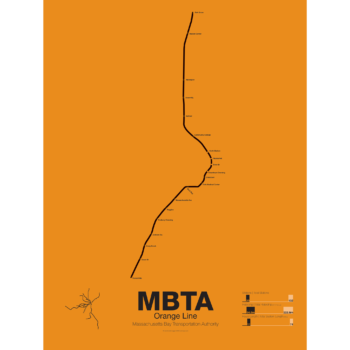
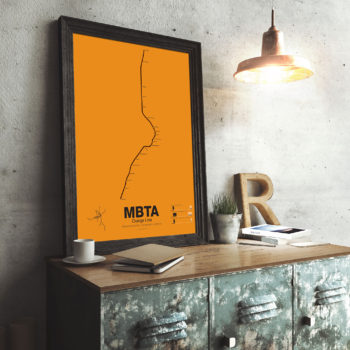 $30.00 – $80.00
$30.00 – $80.00First opened in 1901 the Orange Line was the second part of Boston’s subway system to open. The tunnel under Tremont St was converted from trolleys to heavy rail to allow the new elevated trains from Charlestown to run through to Dudley Sq. in the South End. A second elevated section known as the Atlantic Ave El ran from Castle Sq. in the South End to North Station along Atlantic Ave to serve the maritime industries along the waterfront. In 1904 the Washington St tunnel was opened specifically for use by elevated trains and the Tremont St subway was switched back for trolley use.
The Orange Line was designed to collect commuters at elaborate transfer stations in Charlestown and Roxbury and quickly move them downtown. Suburban stations were spaced farther apart and downtown station platforms were built catty-corner from one another. This spread commuters out so that Boston’s notoriously narrow streets would not be over crowded by subway passengers.
As the city grew so did the Orange Line being extended to Forest Hills and Everett (a further extension to Malden was halted until the 1970s). As the maritime industry faded and ridership dropped the Atlantic Ave El was demolished and sold for scrap during World War II.
While the El served the city well it was not popular as it was loud, dark, and dirty. Plans were laid as early as 1945 to remove the El and rebuild as a subway.
In the 1970s the city canceled ambitious plans to run highways through and around the city and monies were transferred to subway construction. The northern section was rebuilt first, removing the elevated tracks through Charlestown and moving them west along a new subway to Malden in 1975.
The southern section was rebuilt along the route for the canceled I-95 expressway through Jamaica Plain to Forest Hills in 1987. While the new Orange Line was modern and fast the new route bypassed the existing community of Roxbury which relied heavily on mass transit. Service along the old route was replaced by the Silver Line bus in 2002.
Printed on Satin finish 80# cover stock – 220 GSM. Made in the USA! Standard production time is 5 Days. Please add more time for shipping.
Select options This product has multiple variants. The options may be chosen on the product page

